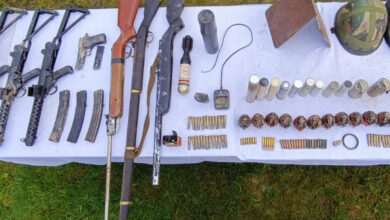These Homegrown Weapons Provide The Indian Army An Advantage In Upcoming Battles

- Infantry Protected Mobility Vehicle (IMPV): M/s Tata Advance Systems Limited introduced two different high mobility vehicle variants that give soldiers both mobility and protection.
- These are specially designed vehicles with increased mobility, firepower, and protection. The development of moral ascendancy on our northern borders will be facilitated by it.
The scales of accommodation (SoA 2022), training modules, and a number of projects of the armed services were officially launched on Tuesday by Rajnath Singh, the defence minister. At a function hosted by the Military Engineering Services (MES), the army’s building arm, he also presented homegrown equipment to the Indian Army.
The MES, led by engineer-in-chief Lt. General Harpal Singh, has created a number of applications, such as the WBPMP (Web-based project monitoring portal), the MES complaint monitoring module ARMAAN (Army Mobile Aadhaar App Network), and online digital payments using SBI-CMP.
Singh also revealed the training modules, which include 198 instructional films on pertinent topics related to modern construction methods. The Scale of Accommodation has also been updated by the MES to ensure that future infrastructural assets meet modern criteria.
Rajnath Singh presented the army with indigenous equipment that would give our soldiers an advantage in combat situations.
1. Landing Craft Assault (LCA): The army has limited-capability boats operating in Pangong Tso Lake. The LCA was created by Goa-based M/s Aquarius Ship Yard Limited and is far more adaptable and has surpassed launch, speed, and capacity restrictions, according to the announcement.
#WATCH | Indian Army showcased capability of the Landing Craft Assault deployed in Pangong lake by the force along the LAC with China to Defence Minister Rajnath Singh today. The boats can carry 35 combat troops at a time and can reach any area of the lake in a very short time pic.twitter.com/ejiJVATY5m
— ANI (@ANI) August 16, 2022
2. Commander Thermal Imaging Sight for Tank T-90: The commanders of the armoured columns benefit from improved visibility and range thanks to this apparatus. The thermal imaging sight, created by India Optel Limited, is better for detection and aiming since it can identify the heat signatures of enemy tanks and equipment.
3. Future Infantry Soldier as a System (F-INSAS): The F-INSAS provides the future infantry soldier with three main sub-systems, including a state-of-the-art assault weapon with holographic and reflex sights for both day and night. A thermal imager sight or an image intensifier sight will be employed, depending on the situation. The sights are attached to both the weapon and the helmet to provide 360-degree view and precision during use.
The second subsystem consists of a helmet and a bulletproof jacket that have been particularly created. Additionally, it will contain modular harnesses and pouches for carrying radios, magazines, grenades, and other operational gear.
A communication and surveillance system makes up the third subsystem. The section commander will also carry additional communication and surveillance equipment for real-time contact with his squad. Each soldier will carry a hands-free radio set.
4. Infantry Protected Mobility Vehicle (IMPV): M/s Tata Advance Systems Limited introduced two different high mobility vehicle variants that give soldiers both mobility and protection.
5. Quick Reaction Fighting Vehicle (Medium): This vehicle makes quick unit deployment and quicker response possible. These are specially designed vehicles with increased mobility, firepower, and protection. The development of moral ascendancy on our northern borders will be facilitated by it.







Facebook Comments